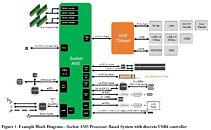Friday, August 20th 2021

No PCIe Gen5 for "Raphael," Says Gigabyte's Leaked Socket AM5 Documentation
AMD might fall behind Intel on PCI-Express Gen 5 support, say sources familiar with the recent GIGABYTE ransomware attack and ensuing leak of confidential documents. If you recall, AMD had extensively marketed the fact that it was first-to-market with PCI-Express Gen 4, over a year ahead of Intel's "Rocket Lake" processor. The platform block-diagram for Socket AM5 states that the AM5 SoC puts out a total of 28 PCI-Express Gen 4 lanes. 16 of these are allocated toward PCI-Express discrete graphics, 4 toward a CPU-attached M.2 NVMe slot, another 4 lanes toward a discrete USB4 controller, and the remaining 4 lanes as chipset-bus.
Socket AM5 SoCs appear to have an additional 4 lanes to spare than the outgoing "Matisse" and "Vermeer" SoCs, which on higher-end platforms are used up by the USB4 controller, but can be left unused for the purpose, and instead wired to an additional M.2 NVMe slot on lower-end motherboards. Thankfully, memory is one area where AMD will maintain parity with Intel, as Socket AM5 is being designed for dual-channel DDR5. The other SoC-integrated I/O, as well as I/O from the chipset, appear to be identical to "Vermeer," with minor exceptions such as support for 20 Gbps USB 3.2x2. The Socket has preparation for display I/O for APUs from the generation. Intel's upcoming "Alder Lake-S" processor implements PCI-Express Gen 5, but only for the 16-lane PEG port. The CPU-attached NVMe slot, as well as downstream PCIe connectivity, are limited to PCIe Gen 4.
Socket AM5 SoCs appear to have an additional 4 lanes to spare than the outgoing "Matisse" and "Vermeer" SoCs, which on higher-end platforms are used up by the USB4 controller, but can be left unused for the purpose, and instead wired to an additional M.2 NVMe slot on lower-end motherboards. Thankfully, memory is one area where AMD will maintain parity with Intel, as Socket AM5 is being designed for dual-channel DDR5. The other SoC-integrated I/O, as well as I/O from the chipset, appear to be identical to "Vermeer," with minor exceptions such as support for 20 Gbps USB 3.2x2. The Socket has preparation for display I/O for APUs from the generation. Intel's upcoming "Alder Lake-S" processor implements PCI-Express Gen 5, but only for the 16-lane PEG port. The CPU-attached NVMe slot, as well as downstream PCIe connectivity, are limited to PCIe Gen 4.

118 Comments on No PCIe Gen5 for "Raphael," Says Gigabyte's Leaked Socket AM5 Documentation
Prebuilts tend to have a single drive, sometimes two, and in the latter case it boils down to one SSD for the operating system and applications, and one hard drive for mass storage. That's it.
And I see the same tendency with most people's machines, prebuilt or not.
and, come on, prebuilts are for dummy people who don't wan't to get themself A GOOD PC, they just are okay with ANY PC, no offense, but i haven't seen any prebuilt better than custom one lol...i just compared like someone calls *good* tendention (some m2 slots) "a niche", and giving example what is really "a niche" - btc crap mobos. ;)
humm, i should check current server mobos. interesting, for real. didn't know that. i understand that servers will benefit from more bw of course.
There are no "good" or "bad" PCs, only varying price/performance/features ratios.
Any PC is good as long as it does exactly what you need/want it to do, within an acceptable price range, within an acceptable performance range, and without unexpected shenanigans.Oh, sure. In general it's weird for a prebuilt to be better than a custom build, at least in terms of absolute performance/features. However, rarely anything is free in this world and when you add the price to the equation, your so superior custom build doesn't necessarily look all that great because of higher price compared to standard prebuilt, and all for features that won't be needed. This is specially true for a big part of the market that just needs a computer for doing basic office work or other non-intensive tasks.
3.0 was an anomaly, like windows XP it lasted a lot longer than usual
The same reason 16 lanes are pushed to the first full length slot (huge over provision) instead of nerfing that to 8 and using those 8 lanes for the chipset instead.
They don't want people stacking i/o cards in consumer boards.
16/4/4 would make the majority of power users really happy, since dual GPU is pretty much dead for gamers
I can split on my z370 though.Interesting I didn't know that, it seems it was done to match the x4 pcie gen 4 bandwidth from AMD, so it will be interesting to see if they drop back to 4 once they have a chipset that is pcie gen 4.
It was interesting to find on a few reviews though where the reviewer stated that slot was just pcie gen 2 from the chipset. :)